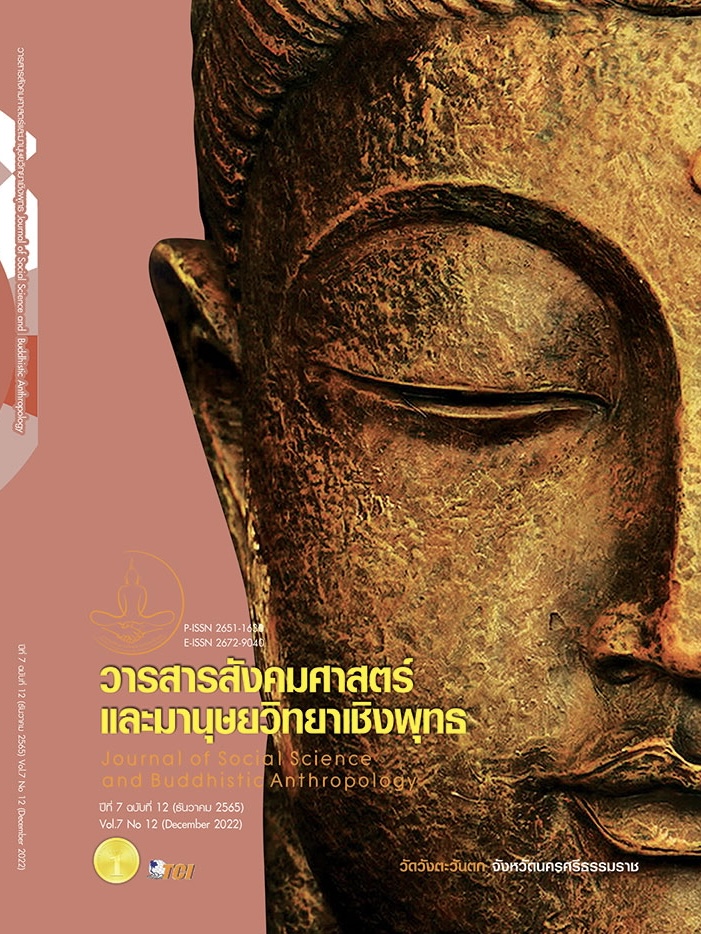THE POTENTIAL TOURIST ATTRACTION DEVELOPMENT OF COMPREHENSIVE TOURIST ATTRACTION OF THE BUDDHIST CIVILIZATION OF NAKHON PATHOM PROVINCE
Keywords:
Development, Potential Tourist Attraction, tourist attractions of Buddhist civilization, Nakhon Pathom ProvinceAbstract
This research aimed to analyze the potential tourist attraction of comprehensive tourist attraction of the Buddhist civilization of Nakhon Pathom Province. This research was quantitative research. The population of this study were Thai tourists who come to travel at historical tourism, and cultural and traditional tourism in Nakhon Pathom Province. According to Yamane's formula, the sample group was Thai tourists who come to travel at historical tourism, and cultural and traditional tourism in Nakhon Pathom Province. Simple random sampling was used to collect dat, for 400 people. The tools used for data collection were questionnaires. The data were analyzed using a statistical program, descriptive statistics were used to analyze the data. The results found that the potential tourist attraction of comprehensive tourist attraction of the Buddhist civilization of Nakhon Pathom Province had potential in all aspects; at a high level. The value of attraction was the aspect with the greatest potential and the facilities of attraction was the least potential aspect. There was knowledge, which was an essential factor in the development of the potential tourist attraction of comprehensive tourist attraction of the Buddhist civilization: 1) value of attraction, 2) safety, 3) facilities, 4) environment, 5) readiness of the tourism destinations, 6) tourism activities organizing, and 7) management. In order to make tourist attractions to be ready to accommodate tourists and encourage community development, in terms of economy, culture, and sustainability.
References
กระทรวงการท่องเที่ยวและกีฬา. (2563). สรุปรายได้และค่าใช้จ่ายการท่องเที่ยวจากนักท่องเที่ยวชาวต่างชาติที่เดินทางเข้าประเทศไทย ปี 2562. เรียกใช้เมื่อ 12 พฤศจิกายน 2563 จาก https://www.mots.go.th/more_news_new.php ?cid=615
ญาณกร โท้ประยูร และคณะ. (2563). การวิเคราะห์ปัจจัยและเปรียบเทียบกลยุทธ์การท่องเที่ยวกับความเปลี่ยนแปลงของเมืองท่องเที่ยวในสาธารณรัฐประชาธิปไตยประชาชนลาว สิบสองปันนา สาธารณรัฐประชาชนจีน และประเทศไทย. วารสารสังคมศาสตร์และมานุษยวิทยาเชิงพุทธ, 5(11), 90-108.
ธนกฤต ยอดอุดม และคณะ. (2564). การพัฒนาการท่องเที่ยวอย่างยั่งยืน: กรณีศึกษาแหล่งท่องเที่ยวของอําเภอพรหมคีรี อําเภอนบพิตํา และอําเภอสิชล จังหวัดนครศรีธรรมราช. วารสารสังคมศาสตร์และมานุษยวิทยาเชิงพุทธ, 6(3), 209-220.
นุชประวีณ์ ลิขิตศรัณย์. (2562). ศักยภาพแหล่งท่องเที่ยวของจังหวัดพิจิตร. วารสารการบริการและการท่องเที่ยวไทย, 14(1), 28-41.
พระครูปลัดประวิทย์ วรธมฺโม. (2563). แนวทางการจัดการท่องเที่ยวเชิงศรัทธาที่ส่งผลต่อการตัดสินใจของนักท่องเที่ยวในการเดินทางมาท่องเที่ยววัดไร่ขิงจังหวัดนครปฐม. วารสารสังคมศาสตร์และมานุษยวิทยาเชิงพุทธ, 5(6), 389-404.
พัชรินทร์ จังประเวศน์. (2560). ความต้องการของชุมชนในการพัฒนาศักยภาพเพื่อการจัดการการท่องเที่ยวเชิงอนุรักษ์: กรณีศึกษาตลาดคลองสวนร้อยปี อำเภอบางบ่อ จังหวัดสมุทรปราการ. วารสารการบริการและการท่องเที่ยวไทย, 12(1), 36-49.
สำนักงานจังหวัดนครปฐม. (2560). บรรยายสรุปจังหวัดนครปฐม 2560. เรียกใช้เมื่อ 12 พฤศจิกายน 2563 จาก http://www.nakhonpathom.go.th/files/com_news_ describe/2017-11_d47c24414a18dec.pdf
Collier, A. & Harraway, S. (1997). Tourism Industry Principles of Tourism. Auckland: Longman Paul Ltd.
Kaplan, S. (1995). The restorative benefits of nature: Toward an integrative framework. Journal of environmental psychology, 15(3), 169-182.
Likert, R. A. (1932). Technique for the Measurement of Attitude. Archives Psychological, 3(1), 42-48.
Yamane, T. (1973). Statistics an Introductory Analysis. (3rd Edition). New York: Harper & Row Ltd.
Downloads
Published
How to Cite
Issue
Section
License
Copyright (c) 2022 Journal of Social Science and Buddhistic Anthropology

This work is licensed under a Creative Commons Attribution-NonCommercial-NoDerivatives 4.0 International License.








